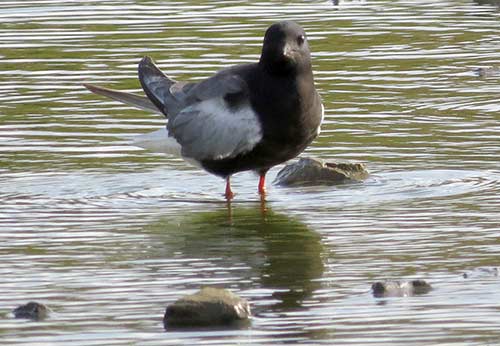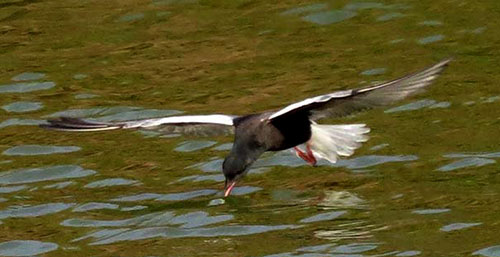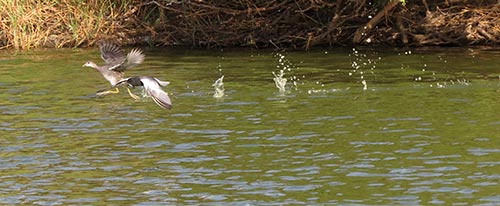The White-winged Tern
What is it doing on Bonaire?
Posted June 21, 2020
The new-to-Bonaire White-winged Tern is a vagrant from Europe or Africa. What is it doing in the Caribbean?
Sighting a vagrant bird is the stuff of dreams! It’s so rare that one has to stop whatever one is doing and get out to see the bird!
That is what happened last week when I received a message from another local birder on Bonaire, that he had seen a never-before-seen-on-Bonaire White-winged Tern at the freshwater ponds of Bonaire’s wastewater treatment facility (interior tour).
Since last week, I have been thrilled to observe this rare bird on three occasions, spending hours watching the vagrant White-winged Tern.
The White-winged Tern is a vagrant from Europe or Africa.
A bird is considered a vagrant if it strays far outside its expected breeding, wintering, or migrating range. The White-winged Tern, Chlidonias leucopterus, is a species of small tern in the family Laridae; the genus name is from the ancient Greek word “khelidonios,” which means swallow-like, or from the word “khelidon” for swallow. The White-winged Tern is generally found near bodies of fresh water in Europe, but, in winter, they migrate to Africa, southern Asia, and Australia. It is a scarce vagrant in North America, mainly sighted on the Atlantic coast, but there are a few records from the Pacific coast and inland in the Great Lakes area.
So what is it doing in the Caribbean? That is an excellent question!
Although this sighting on Bonaire is not the first vagrant sighting of the White-winged Tern in the Caribbean, it IS the first sighting for the ABC islands–Aruba, Bonaire, or Curacao–so it’s a very exciting find! White-winged terns have also been reported in Puerto Rico, Guadeloupe, Barbados, and the U.S. Virgin Islands, as well as southern Brazil, Paraguay, and Argentina in South America.
We shall never know exactly how these Eurasian or African birds arrive in the New World, but one theory is that perhaps they were blown west in a storm. It’s a known phenomenon that birds, especially seabirds or migrating birds, can get into the trailing ends of a hurricane’s spiral, and they will tend to move toward the eye of the storm, where winds are calmer. It’s easier to stay in the eye than to fight the high winds surrounding it, so as the storm moves west, so do the birds within its eye. Once the storm reaches land, it can begin to lose strength and the birds are able to get out of the storm. However, they find themselves in a new location!
How to identify the White-winged Tern.
The White-winged tern observed here on Bonaire is in breeding plumage, so it displays short red legs and a short black bill, a black neck and belly, a very dark grey back, with a white rump and tail. The wings, as the name implies, are mainly white. The inner wing is grayish with brown-tipped coverts.
Like other marsh terns, the White-winged Tern does not dive for fish, but rather skims and dips up and down along the surface of the water. It will dip its head beneath the surface to catch small fish, but it will also feast upon insects while in flight.
It utilizes a shallow and leisurely wingbeat, which makes for a striking view when the bird is in breeding plumage, as one sees the alternating white and black with each wingbeat. They exhibit great aerial agility, which is probably the reason for the name-sake “swallow.”
Behavioral Observations of the White-winged Tern.
While observing this bird for quite some hours, it could be easily noted that, while “new to the pond,” this White-winged Tern already “owned” it. From the first days that the bird was observed on Bonaire, it was chasing away anything near it–even though the interloper might not pose a threat or be competition–including birds much larger, such as Laughing Gulls, and even an immature Common Gallinule, minding its own business.
At first, the only birds it would yield to were the Magnificent Frigatebirds. When they arrived at the pond, the White-winged Tern would alight on shore and wait until the frigatebirds were done.
However, after a week of sharing the pond, it appears the tern and the frigatebirds have come to terms and are sharing the pond, although each still keeping a respectful (social) distance.
Will this rare vagrant tern stay on Bonaire?
Will we continue to be delighted in watching the high energy of this rare vagrant to Bonaire? Perhaps the White-Winged Tern will decide Bonaire suits it……….or perhaps it will move on. Only time will tell!
About the author
Susan has been living on Bonaire for over 30 years. She is a certified bird guide, a PADI SCUBA Diving Master Instructor, and an underwater and topside photographer.

Reach out to Susan
Contact Susan via email, Facebook Messenger, give Susan a call, or simply use the online form below.
If you have any questions in regard to your birding tour on Bonaire, feel free to contact Susan to get answers. She is always happy to elaborate on routes or best times for a tour based upon your own personal preferences. Tours can be tailored to your own interests, whether that be birds, photography, or both!
It is also recommended that you do some homework about Bonaire's birds before you visit. By knowing a little bit about the birds which might be encountered on tour, your enjoyment will be heightened! Be sure to check out these resources for Bonaire Birding. Reading the Bonaire Bird Blog will also accustom you to the birds that habitually are encountered on Bonaire.
Facebook Messenger
Get in touch via Facebook Messenger
Telephone
Get In Touch
Get in touch with Susan to check availability for the dates you are visiting Bonaire.
Consent: By using this form you agree with the storage and handling of your data by this website.




